SBM4303: Enterprise Architecture Report: Frameworks, ERD, and Big Data
VerifiedAdded on 2021/02/20
|12
|2633
|27
Report
AI Summary
This report provides a comprehensive overview of Enterprise Architecture (EA), examining its structure, operation, and its role in helping enterprises achieve their objectives. The report begins with a case study of Johnson & Johnson (J&J), highlighting the company's challenges with IT integration and proposing solutions such as phased IT personnel training and corporate funding. It then explores the Zachman Framework, explaining its application in structuring business processes and determining IT structures. The report further compares various EA frameworks including Zachman, TOGAF, and FEA, and discusses the relationship between EA and Service-Oriented Architecture (SOA). It includes an ERD diagram for Milk Dairy and Quikfix Electronics, followed by a review of journal articles that discuss the root causes behind the failure of big data projects, and how EA can support successful big data project implementation. The report concludes with recommendations for security and encryption in big data projects.
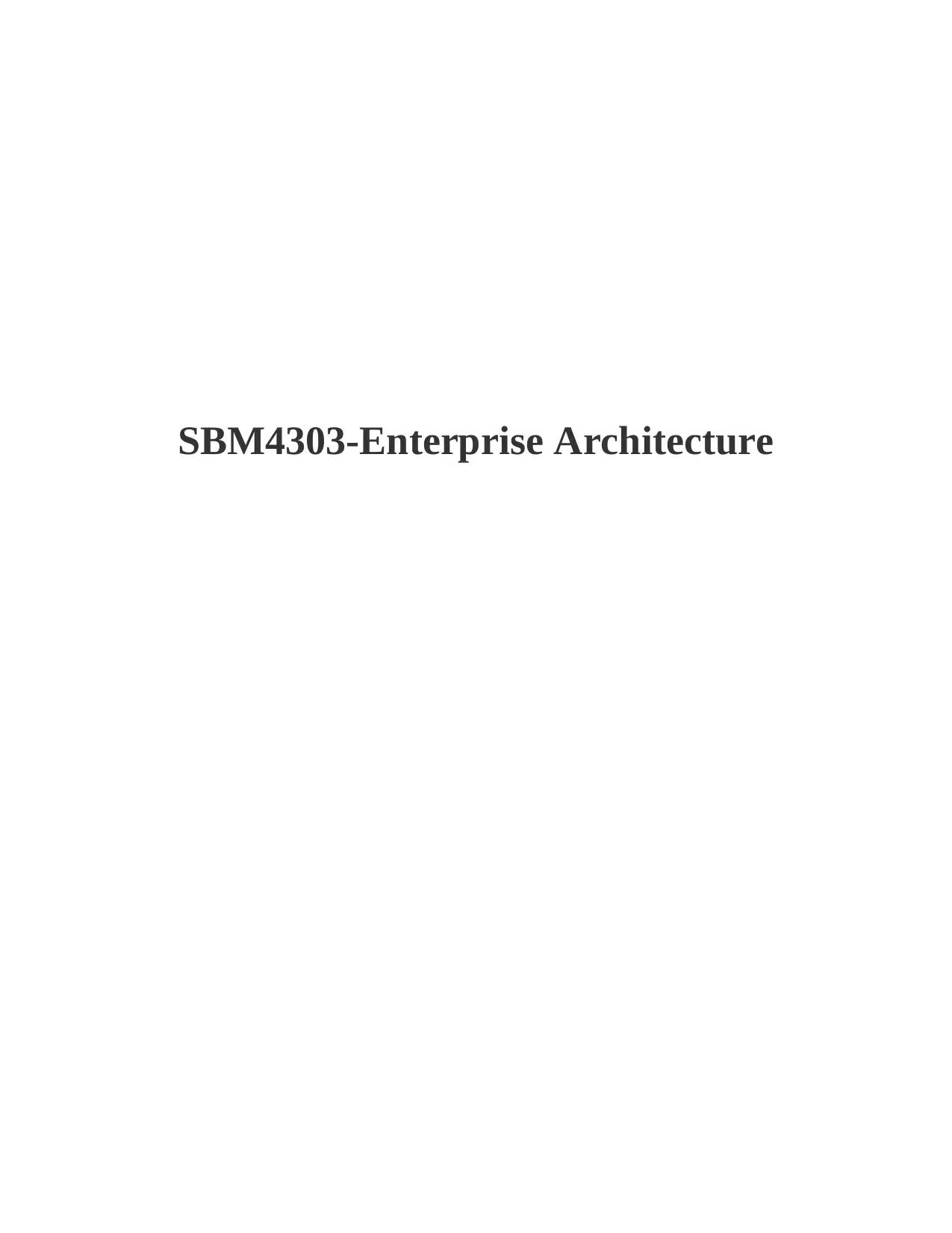
SBM4303-Enterprise Architecture
Paraphrase This Document
Need a fresh take? Get an instant paraphrase of this document with our AI Paraphraser
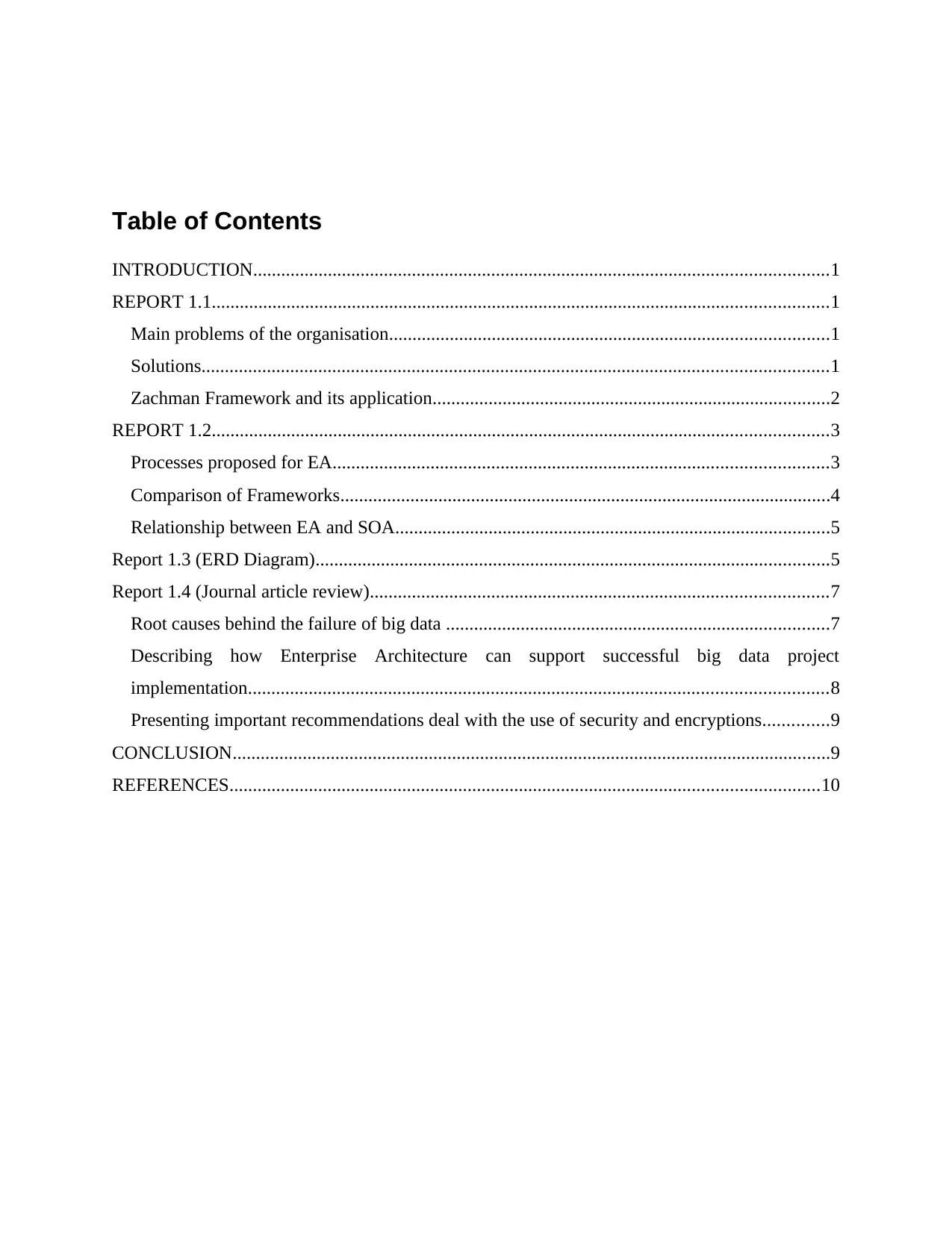
Table of Contents
INTRODUCTION...........................................................................................................................1
REPORT 1.1....................................................................................................................................1
Main problems of the organisation..............................................................................................1
Solutions......................................................................................................................................1
Zachman Framework and its application.....................................................................................2
REPORT 1.2....................................................................................................................................3
Processes proposed for EA..........................................................................................................3
Comparison of Frameworks.........................................................................................................4
Relationship between EA and SOA.............................................................................................5
Report 1.3 (ERD Diagram)..............................................................................................................5
Report 1.4 (Journal article review)..................................................................................................7
Root causes behind the failure of big data ..................................................................................7
Describing how Enterprise Architecture can support successful big data project
implementation............................................................................................................................8
Presenting important recommendations deal with the use of security and encryptions..............9
CONCLUSION................................................................................................................................9
REFERENCES..............................................................................................................................10
INTRODUCTION...........................................................................................................................1
REPORT 1.1....................................................................................................................................1
Main problems of the organisation..............................................................................................1
Solutions......................................................................................................................................1
Zachman Framework and its application.....................................................................................2
REPORT 1.2....................................................................................................................................3
Processes proposed for EA..........................................................................................................3
Comparison of Frameworks.........................................................................................................4
Relationship between EA and SOA.............................................................................................5
Report 1.3 (ERD Diagram)..............................................................................................................5
Report 1.4 (Journal article review)..................................................................................................7
Root causes behind the failure of big data ..................................................................................7
Describing how Enterprise Architecture can support successful big data project
implementation............................................................................................................................8
Presenting important recommendations deal with the use of security and encryptions..............9
CONCLUSION................................................................................................................................9
REFERENCES..............................................................................................................................10
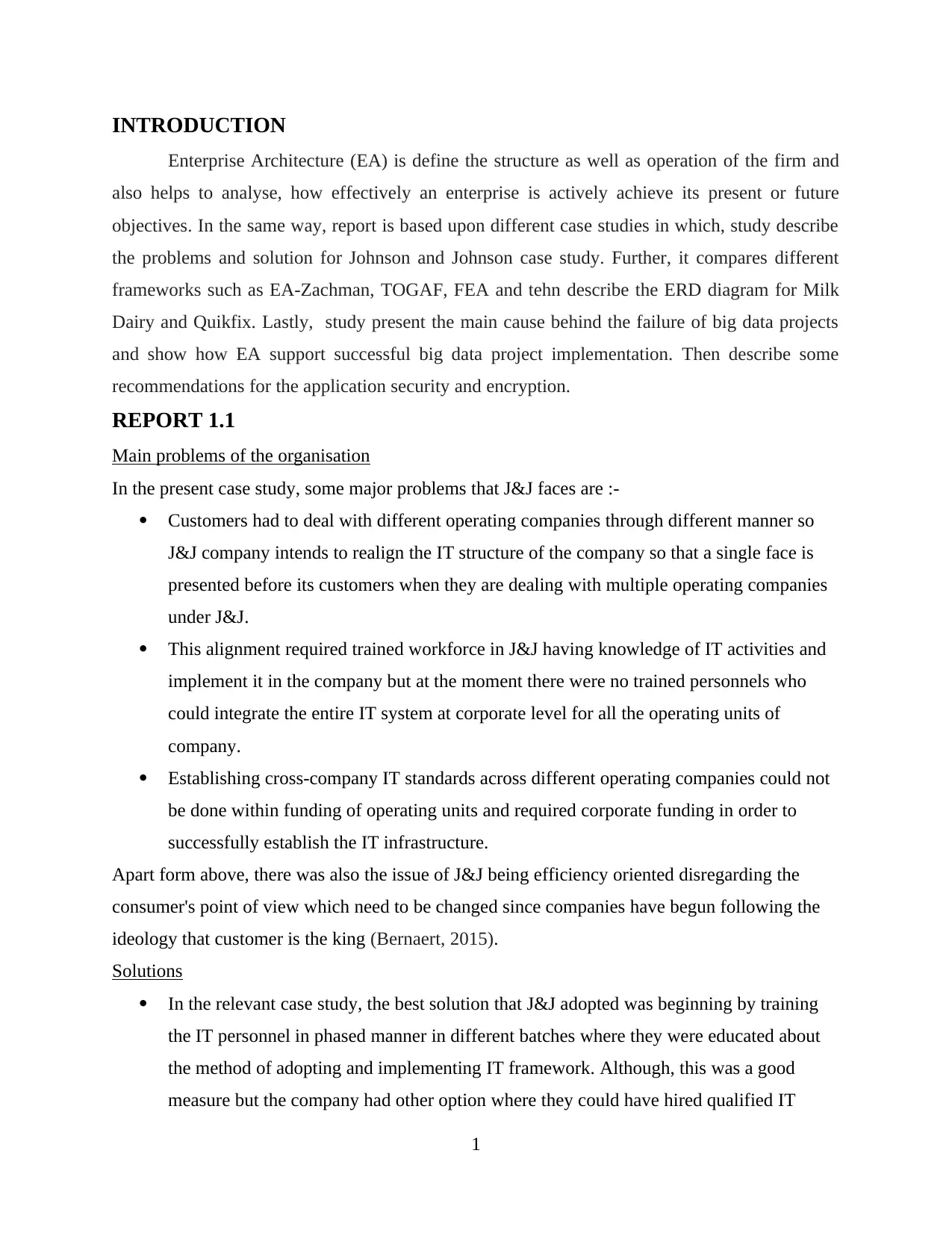
INTRODUCTION
Enterprise Architecture (EA) is define the structure as well as operation of the firm and
also helps to analyse, how effectively an enterprise is actively achieve its present or future
objectives. In the same way, report is based upon different case studies in which, study describe
the problems and solution for Johnson and Johnson case study. Further, it compares different
frameworks such as EA-Zachman, TOGAF, FEA and tehn describe the ERD diagram for Milk
Dairy and Quikfix. Lastly, study present the main cause behind the failure of big data projects
and show how EA support successful big data project implementation. Then describe some
recommendations for the application security and encryption.
REPORT 1.1
Main problems of the organisation
In the present case study, some major problems that J&J faces are :-
Customers had to deal with different operating companies through different manner so
J&J company intends to realign the IT structure of the company so that a single face is
presented before its customers when they are dealing with multiple operating companies
under J&J.
This alignment required trained workforce in J&J having knowledge of IT activities and
implement it in the company but at the moment there were no trained personnels who
could integrate the entire IT system at corporate level for all the operating units of
company.
Establishing cross-company IT standards across different operating companies could not
be done within funding of operating units and required corporate funding in order to
successfully establish the IT infrastructure.
Apart form above, there was also the issue of J&J being efficiency oriented disregarding the
consumer's point of view which need to be changed since companies have begun following the
ideology that customer is the king (Bernaert, 2015).
Solutions
In the relevant case study, the best solution that J&J adopted was beginning by training
the IT personnel in phased manner in different batches where they were educated about
the method of adopting and implementing IT framework. Although, this was a good
measure but the company had other option where they could have hired qualified IT
1
Enterprise Architecture (EA) is define the structure as well as operation of the firm and
also helps to analyse, how effectively an enterprise is actively achieve its present or future
objectives. In the same way, report is based upon different case studies in which, study describe
the problems and solution for Johnson and Johnson case study. Further, it compares different
frameworks such as EA-Zachman, TOGAF, FEA and tehn describe the ERD diagram for Milk
Dairy and Quikfix. Lastly, study present the main cause behind the failure of big data projects
and show how EA support successful big data project implementation. Then describe some
recommendations for the application security and encryption.
REPORT 1.1
Main problems of the organisation
In the present case study, some major problems that J&J faces are :-
Customers had to deal with different operating companies through different manner so
J&J company intends to realign the IT structure of the company so that a single face is
presented before its customers when they are dealing with multiple operating companies
under J&J.
This alignment required trained workforce in J&J having knowledge of IT activities and
implement it in the company but at the moment there were no trained personnels who
could integrate the entire IT system at corporate level for all the operating units of
company.
Establishing cross-company IT standards across different operating companies could not
be done within funding of operating units and required corporate funding in order to
successfully establish the IT infrastructure.
Apart form above, there was also the issue of J&J being efficiency oriented disregarding the
consumer's point of view which need to be changed since companies have begun following the
ideology that customer is the king (Bernaert, 2015).
Solutions
In the relevant case study, the best solution that J&J adopted was beginning by training
the IT personnel in phased manner in different batches where they were educated about
the method of adopting and implementing IT framework. Although, this was a good
measure but the company had other option where they could have hired qualified IT
1
⊘ This is a preview!⊘
Do you want full access?
Subscribe today to unlock all pages.

Trusted by 1+ million students worldwide
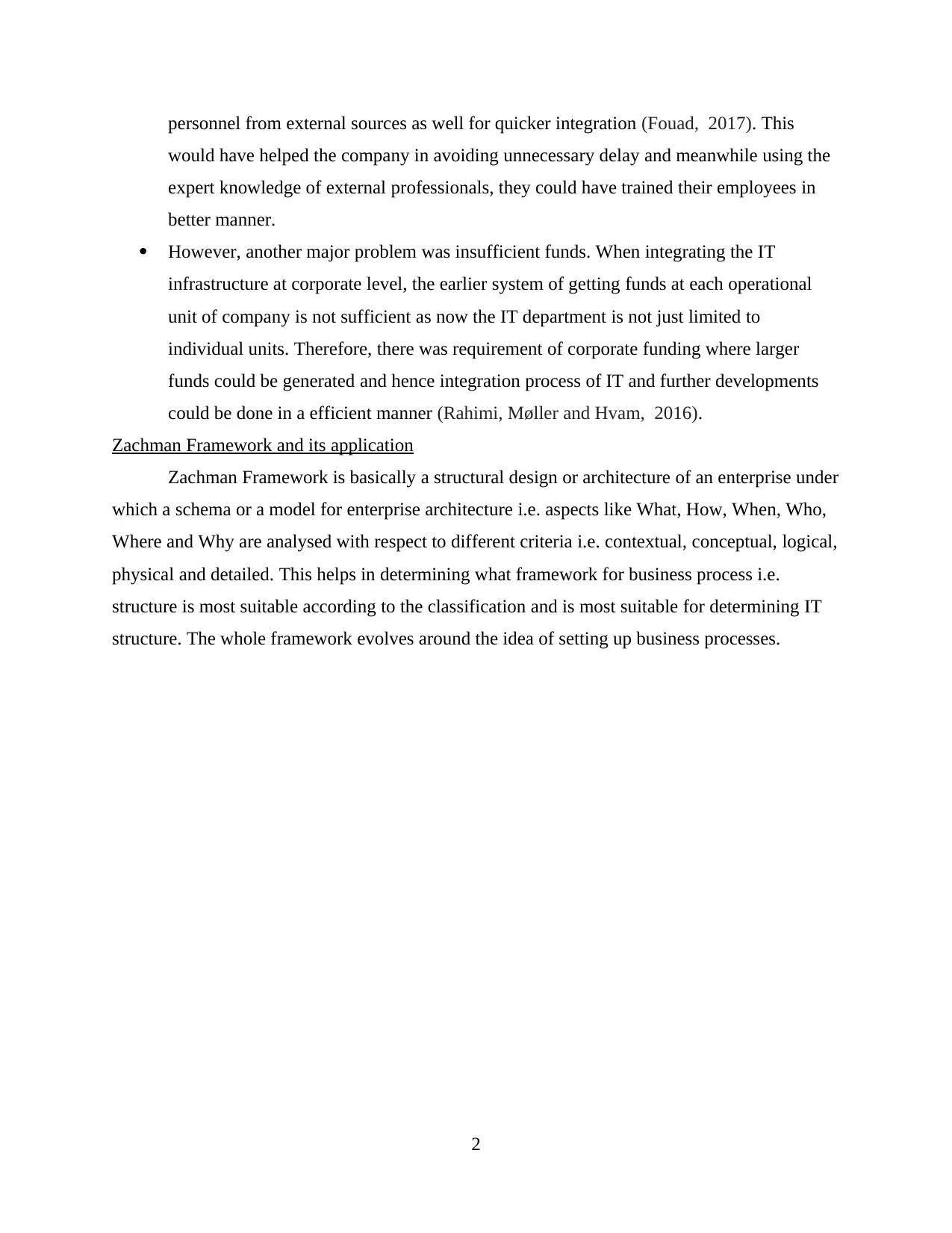
personnel from external sources as well for quicker integration (Fouad, 2017). This
would have helped the company in avoiding unnecessary delay and meanwhile using the
expert knowledge of external professionals, they could have trained their employees in
better manner.
However, another major problem was insufficient funds. When integrating the IT
infrastructure at corporate level, the earlier system of getting funds at each operational
unit of company is not sufficient as now the IT department is not just limited to
individual units. Therefore, there was requirement of corporate funding where larger
funds could be generated and hence integration process of IT and further developments
could be done in a efficient manner (Rahimi, Møller and Hvam, 2016).
Zachman Framework and its application
Zachman Framework is basically a structural design or architecture of an enterprise under
which a schema or a model for enterprise architecture i.e. aspects like What, How, When, Who,
Where and Why are analysed with respect to different criteria i.e. contextual, conceptual, logical,
physical and detailed. This helps in determining what framework for business process i.e.
structure is most suitable according to the classification and is most suitable for determining IT
structure. The whole framework evolves around the idea of setting up business processes.
2
would have helped the company in avoiding unnecessary delay and meanwhile using the
expert knowledge of external professionals, they could have trained their employees in
better manner.
However, another major problem was insufficient funds. When integrating the IT
infrastructure at corporate level, the earlier system of getting funds at each operational
unit of company is not sufficient as now the IT department is not just limited to
individual units. Therefore, there was requirement of corporate funding where larger
funds could be generated and hence integration process of IT and further developments
could be done in a efficient manner (Rahimi, Møller and Hvam, 2016).
Zachman Framework and its application
Zachman Framework is basically a structural design or architecture of an enterprise under
which a schema or a model for enterprise architecture i.e. aspects like What, How, When, Who,
Where and Why are analysed with respect to different criteria i.e. contextual, conceptual, logical,
physical and detailed. This helps in determining what framework for business process i.e.
structure is most suitable according to the classification and is most suitable for determining IT
structure. The whole framework evolves around the idea of setting up business processes.
2
Paraphrase This Document
Need a fresh take? Get an instant paraphrase of this document with our AI Paraphraser
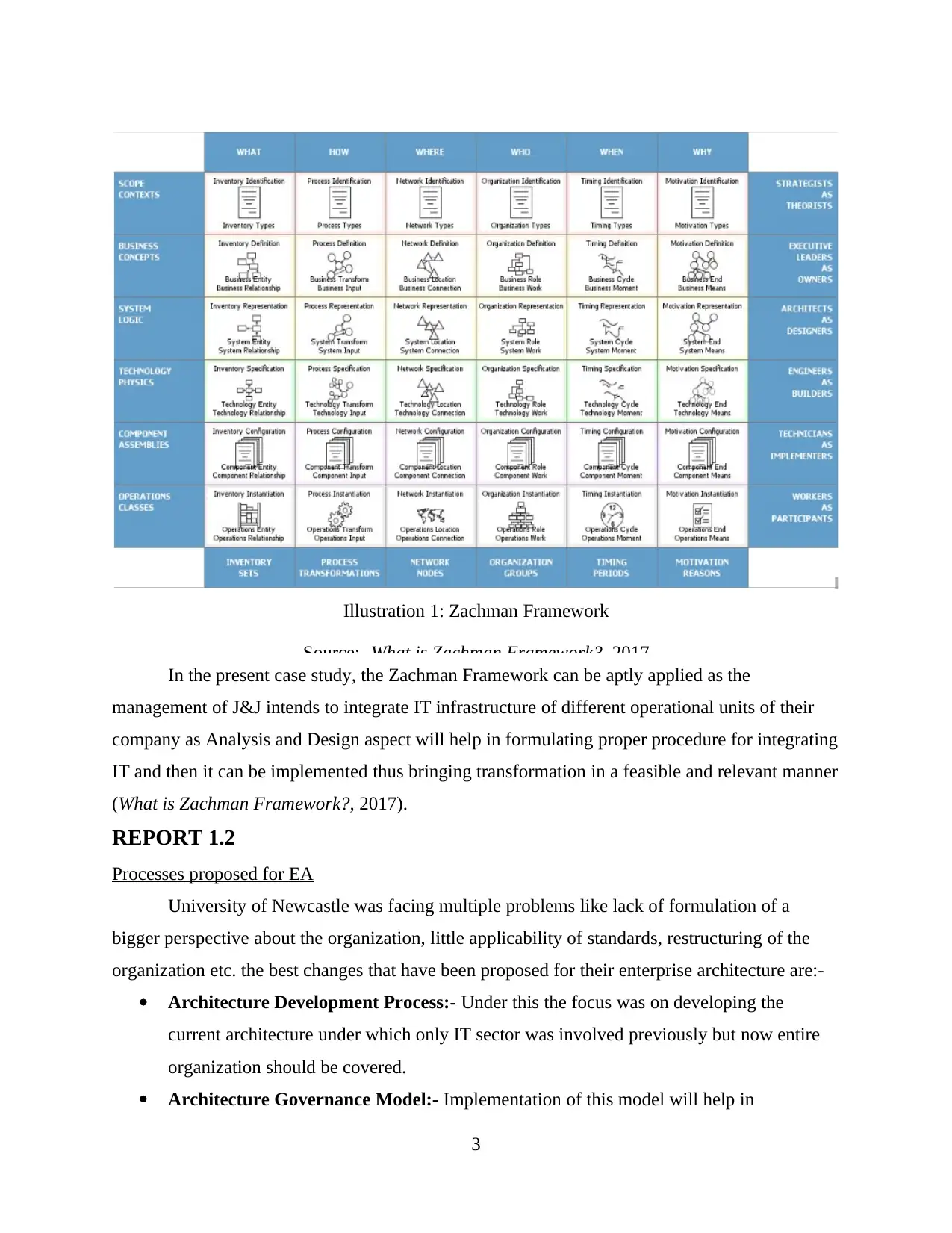
In the present case study, the Zachman Framework can be aptly applied as the
management of J&J intends to integrate IT infrastructure of different operational units of their
company as Analysis and Design aspect will help in formulating proper procedure for integrating
IT and then it can be implemented thus bringing transformation in a feasible and relevant manner
(What is Zachman Framework?, 2017).
REPORT 1.2
Processes proposed for EA
University of Newcastle was facing multiple problems like lack of formulation of a
bigger perspective about the organization, little applicability of standards, restructuring of the
organization etc. the best changes that have been proposed for their enterprise architecture are:-
Architecture Development Process:- Under this the focus was on developing the
current architecture under which only IT sector was involved previously but now entire
organization should be covered.
Architecture Governance Model:- Implementation of this model will help in
3
Illustration 1: Zachman Framework
Source:- What is Zachman Framework?, 2017
management of J&J intends to integrate IT infrastructure of different operational units of their
company as Analysis and Design aspect will help in formulating proper procedure for integrating
IT and then it can be implemented thus bringing transformation in a feasible and relevant manner
(What is Zachman Framework?, 2017).
REPORT 1.2
Processes proposed for EA
University of Newcastle was facing multiple problems like lack of formulation of a
bigger perspective about the organization, little applicability of standards, restructuring of the
organization etc. the best changes that have been proposed for their enterprise architecture are:-
Architecture Development Process:- Under this the focus was on developing the
current architecture under which only IT sector was involved previously but now entire
organization should be covered.
Architecture Governance Model:- Implementation of this model will help in
3
Illustration 1: Zachman Framework
Source:- What is Zachman Framework?, 2017

developing proper governance standards and models along with review of the
architecture on a regular basis.
Architecture Services for Projects:- This process will help in implementation of
architecture in different departments formulated in UoN and link them to the Enterprise
Architecture.
Collectively implementation of these process will help in setting up enterprise
architecture outside IT sector as well and formulating a separate department for monitoring EA
will help in continuous monitoring an evaluation so that the management can formulate proactive
strategies rather than reactive strategies.
Comparison of Frameworks
Zachman TOGAF FEA Gartner
Despite the word
framework as its
suffix, this can be
more aptly called a
Taxonomy.
This is also more of a
process and less of a
framework.
It can be viewed as
prospective
methodology for
implementing
enterprise architecture
(Yu, 2015).
This can be illustrated
as a practice of
enterprise architecture.
The main dimensions
are used whee one
evaluates the different
players i.e. different
parties or stakeholders
are identified and
second dimension
involves descriptive
analysis i.e. what,
who, when, where,
how and why (What is
Zachman
Framework?, 2017).
Three major phases
are involved here-
Phase A under which
architectural vision is
created, Phase B in
which business
modelling, detailed
business analysis and
technical requirements
are ascertained and
Phase C under which
information system
architecture for output
Three main categories
are Architectural
Completion,
Architectural Use and
Architectural Results
which help in
determining success
using light indicator
i.e. Green, yellow and
blue.
Gartner involves three
main components i.e.
business owners,
information specialists
and technology
implementers and
emphasizes on
integration of these
three aspects in order
to succeed.
4
architecture on a regular basis.
Architecture Services for Projects:- This process will help in implementation of
architecture in different departments formulated in UoN and link them to the Enterprise
Architecture.
Collectively implementation of these process will help in setting up enterprise
architecture outside IT sector as well and formulating a separate department for monitoring EA
will help in continuous monitoring an evaluation so that the management can formulate proactive
strategies rather than reactive strategies.
Comparison of Frameworks
Zachman TOGAF FEA Gartner
Despite the word
framework as its
suffix, this can be
more aptly called a
Taxonomy.
This is also more of a
process and less of a
framework.
It can be viewed as
prospective
methodology for
implementing
enterprise architecture
(Yu, 2015).
This can be illustrated
as a practice of
enterprise architecture.
The main dimensions
are used whee one
evaluates the different
players i.e. different
parties or stakeholders
are identified and
second dimension
involves descriptive
analysis i.e. what,
who, when, where,
how and why (What is
Zachman
Framework?, 2017).
Three major phases
are involved here-
Phase A under which
architectural vision is
created, Phase B in
which business
modelling, detailed
business analysis and
technical requirements
are ascertained and
Phase C under which
information system
architecture for output
Three main categories
are Architectural
Completion,
Architectural Use and
Architectural Results
which help in
determining success
using light indicator
i.e. Green, yellow and
blue.
Gartner involves three
main components i.e.
business owners,
information specialists
and technology
implementers and
emphasizes on
integration of these
three aspects in order
to succeed.
4
⊘ This is a preview!⊘
Do you want full access?
Subscribe today to unlock all pages.

Trusted by 1+ million students worldwide

of Phase B is prepared.
Relationship between EA and SOA
Service Oriented Architecture (SOA) supports EA through many aspects:-
Both SOA and EA have long been disputed where one is tried to put over other when in
reality both are synergetic toward achievement of corporate strategies and performance
measures.
Both of them help in aligning the IT infrastructure in organizations and use business
objectives as inputs.
There might be contradictory decisions taken at workplace which can be disastrous but
implementation of SOA and EA in integrated manner helps in avoiding this mistake and
ensuring that positive outcomes are generated (Kistasamy ,Merwe and Harpe, 2010).
Report 1.3 (ERD Diagram)
ERD diagram of Milk Dairy
5
Relationship between EA and SOA
Service Oriented Architecture (SOA) supports EA through many aspects:-
Both SOA and EA have long been disputed where one is tried to put over other when in
reality both are synergetic toward achievement of corporate strategies and performance
measures.
Both of them help in aligning the IT infrastructure in organizations and use business
objectives as inputs.
There might be contradictory decisions taken at workplace which can be disastrous but
implementation of SOA and EA in integrated manner helps in avoiding this mistake and
ensuring that positive outcomes are generated (Kistasamy ,Merwe and Harpe, 2010).
Report 1.3 (ERD Diagram)
ERD diagram of Milk Dairy
5
Paraphrase This Document
Need a fresh take? Get an instant paraphrase of this document with our AI Paraphraser
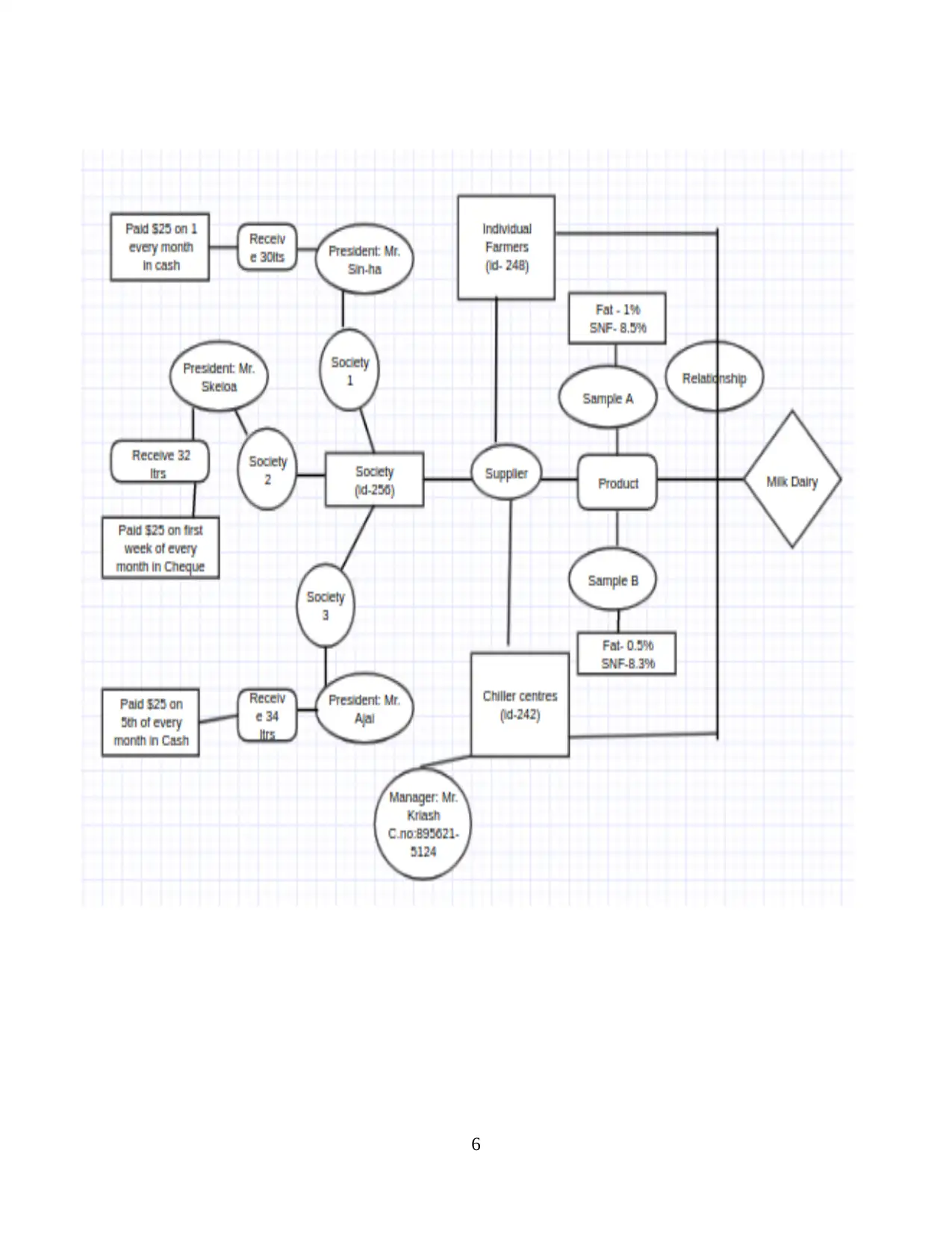
6
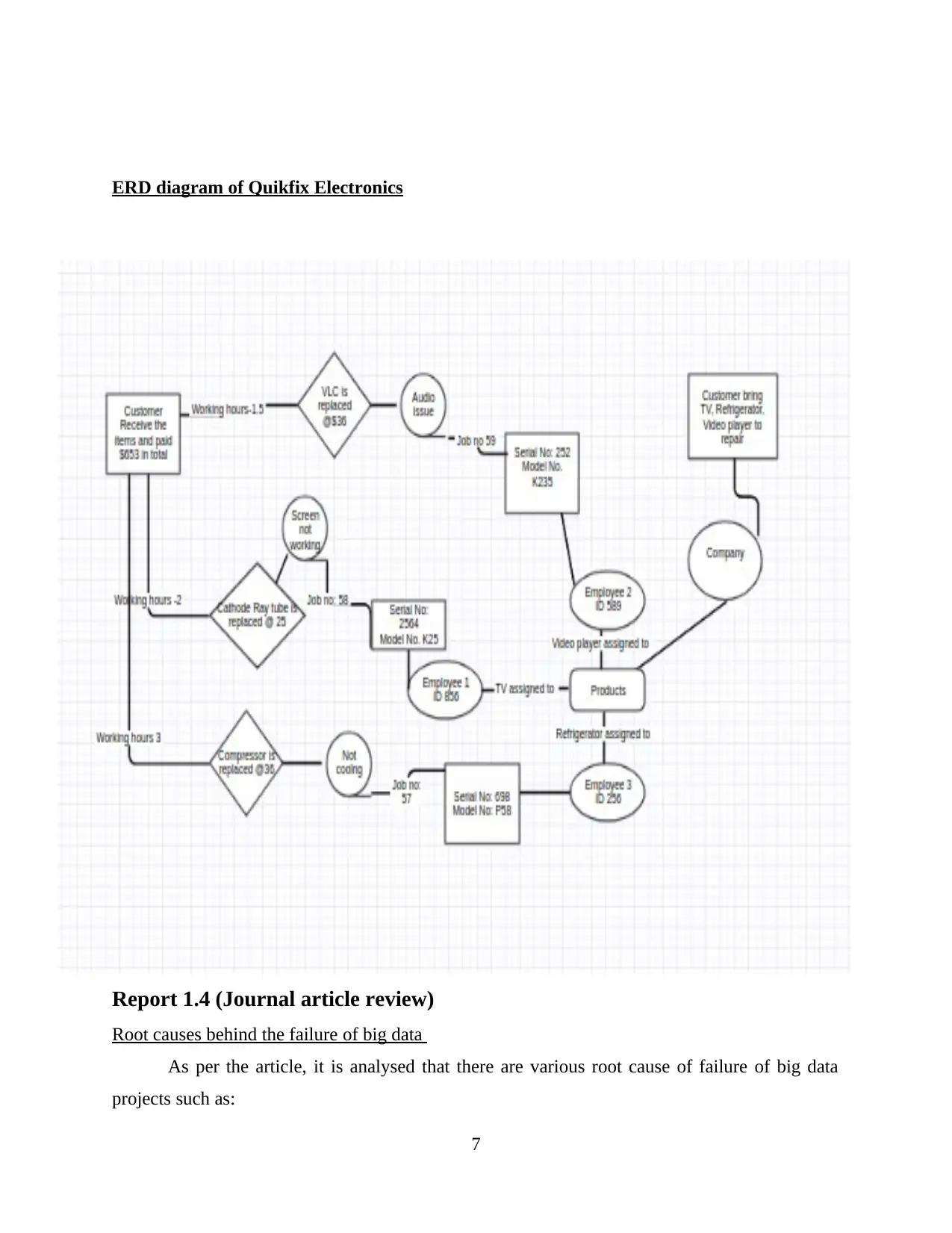
ERD diagram of Quikfix Electronics
Report 1.4 (Journal article review)
Root causes behind the failure of big data
As per the article, it is analysed that there are various root cause of failure of big data
projects such as:
7
Report 1.4 (Journal article review)
Root causes behind the failure of big data
As per the article, it is analysed that there are various root cause of failure of big data
projects such as:
7
⊘ This is a preview!⊘
Do you want full access?
Subscribe today to unlock all pages.

Trusted by 1+ million students worldwide

The first cause is No business Goal and there is no alignment with business
requirement, in which the experts did not have a clear business goal in their initial steps.
Even many of the big data projects are started very quickly without there any alignment
with requirement.
Next is, Poor planning and Failure to identify the project scope in which IT manager
did not give enough time to focus on the planning, it is so because of pressure from their
seniors. Thus it leads to cause fails (LEE and Kim, 2019).
Another cause is Lack of access to data and not having effective communication
between stakeholders, in which experts wants to encounter challenges, but due to lack
of stakeholder trust, confidence in the accuracy of the data.
Change management issue is another root cause in which the big project may require
different changes but the stakeholders become unwilling to accept the change. As a
result, they dismiss the faulty process change and did not accept new trends which cause
project failure.
Most of the big project are plan in testing technology rather than define the opportunity .
Therefore, another cause is Focus on technology rather than business opportunities,
this lead towards failure as they are experimenting on the projects without focusing on
business opportunities (Alexander, 2019)..
Describing how Enterprise Architecture can support successful big data project implementation
Enterprise project governance is a framework that makes sure that all the phases of
project are aligned with the business requirements or strategy, that further balance out with
corporate governance and also check that all stakeholders are agreed with it. Moreover, this
framework also monitor and confirms that the entire project is on track or not. Moreover, if the
experts find any gap then it must be filled by using Enterprise Architecture Practice in a firm.
Therefore, it shows that the EA act as a bridge between the strategy and execution so that it helps
in the successful implementation of the big project (Boer and et.al., 2019).
On the other side, it is also analysed through an article that enterprise project governance
is the essential disciplines of EA for effective execution of a business strategy. But there are
different execution strategy such as performance engineering and management, process
engineering and management, IT strategic planning and metabase management and different
technical disciplines as well (Jouini and Rabai, 2019). Thus, EA uses project portfolio
8
requirement, in which the experts did not have a clear business goal in their initial steps.
Even many of the big data projects are started very quickly without there any alignment
with requirement.
Next is, Poor planning and Failure to identify the project scope in which IT manager
did not give enough time to focus on the planning, it is so because of pressure from their
seniors. Thus it leads to cause fails (LEE and Kim, 2019).
Another cause is Lack of access to data and not having effective communication
between stakeholders, in which experts wants to encounter challenges, but due to lack
of stakeholder trust, confidence in the accuracy of the data.
Change management issue is another root cause in which the big project may require
different changes but the stakeholders become unwilling to accept the change. As a
result, they dismiss the faulty process change and did not accept new trends which cause
project failure.
Most of the big project are plan in testing technology rather than define the opportunity .
Therefore, another cause is Focus on technology rather than business opportunities,
this lead towards failure as they are experimenting on the projects without focusing on
business opportunities (Alexander, 2019)..
Describing how Enterprise Architecture can support successful big data project implementation
Enterprise project governance is a framework that makes sure that all the phases of
project are aligned with the business requirements or strategy, that further balance out with
corporate governance and also check that all stakeholders are agreed with it. Moreover, this
framework also monitor and confirms that the entire project is on track or not. Moreover, if the
experts find any gap then it must be filled by using Enterprise Architecture Practice in a firm.
Therefore, it shows that the EA act as a bridge between the strategy and execution so that it helps
in the successful implementation of the big project (Boer and et.al., 2019).
On the other side, it is also analysed through an article that enterprise project governance
is the essential disciplines of EA for effective execution of a business strategy. But there are
different execution strategy such as performance engineering and management, process
engineering and management, IT strategic planning and metabase management and different
technical disciplines as well (Jouini and Rabai, 2019). Thus, EA uses project portfolio
8
Paraphrase This Document
Need a fresh take? Get an instant paraphrase of this document with our AI Paraphraser

management in order to prioritise the business goals and allocate the resources as well, this helps
to increase the success of the project and assure that the project is align with the defined strategy.
Moreover, EA also contribute to big data planning which helps to define project scope and also
prevent the project from misaligned. Therefore, through different frameworks, EA helps in
successful implementation of the big project data.
Presenting important recommendations deal with the use of security and encryptions
As per the article of “Enterprise Architecture for Cloud Computing” There are different
recommendations involve in the use of security and encryptions such as:
In the business, the management of the application document is critical and that is why
they have to be protected and secured.
The business must use encryption in order to secure the storage of data in the cloud
computing. Moreover, in the same way, information should be protected by the
encryption method in the cloud computing as well as in external system too.
If the business chooses any specific encryption for protection, make sure that it comply
with government standards (Wang, Li and Wang, 2019).
It is further recommended to the firm that whatever the keys are used for encrypt the data,
it must be protected whenever they are stored or backed up.
If the data is encrypted even in the transit stage, then company should use Cloud
Provider's network which is more secured as compared to Internet. Moreover, the virtual
machine files and temporary data needs to be encrypted in definite time period.
CONCLUSION
From the above report, it has been concluded that as per the case study of J&J, company
faces the issue of funding and IT integration which is minimized by establishing the IT structure
at single company. Further, report also concluded difference between the frameworks such as
EA-Zachman, TOGAF, FEA, further, as per the article of EA and Big data, report concluded
different causes of the failure of big data projects, but EA provide different solution or
framework for the project's successful implementation. Lastly, report concluded some
recommendations for the security and encryption through EA and Cloud Computing article.
9
to increase the success of the project and assure that the project is align with the defined strategy.
Moreover, EA also contribute to big data planning which helps to define project scope and also
prevent the project from misaligned. Therefore, through different frameworks, EA helps in
successful implementation of the big project data.
Presenting important recommendations deal with the use of security and encryptions
As per the article of “Enterprise Architecture for Cloud Computing” There are different
recommendations involve in the use of security and encryptions such as:
In the business, the management of the application document is critical and that is why
they have to be protected and secured.
The business must use encryption in order to secure the storage of data in the cloud
computing. Moreover, in the same way, information should be protected by the
encryption method in the cloud computing as well as in external system too.
If the business chooses any specific encryption for protection, make sure that it comply
with government standards (Wang, Li and Wang, 2019).
It is further recommended to the firm that whatever the keys are used for encrypt the data,
it must be protected whenever they are stored or backed up.
If the data is encrypted even in the transit stage, then company should use Cloud
Provider's network which is more secured as compared to Internet. Moreover, the virtual
machine files and temporary data needs to be encrypted in definite time period.
CONCLUSION
From the above report, it has been concluded that as per the case study of J&J, company
faces the issue of funding and IT integration which is minimized by establishing the IT structure
at single company. Further, report also concluded difference between the frameworks such as
EA-Zachman, TOGAF, FEA, further, as per the article of EA and Big data, report concluded
different causes of the failure of big data projects, but EA provide different solution or
framework for the project's successful implementation. Lastly, report concluded some
recommendations for the security and encryption through EA and Cloud Computing article.
9
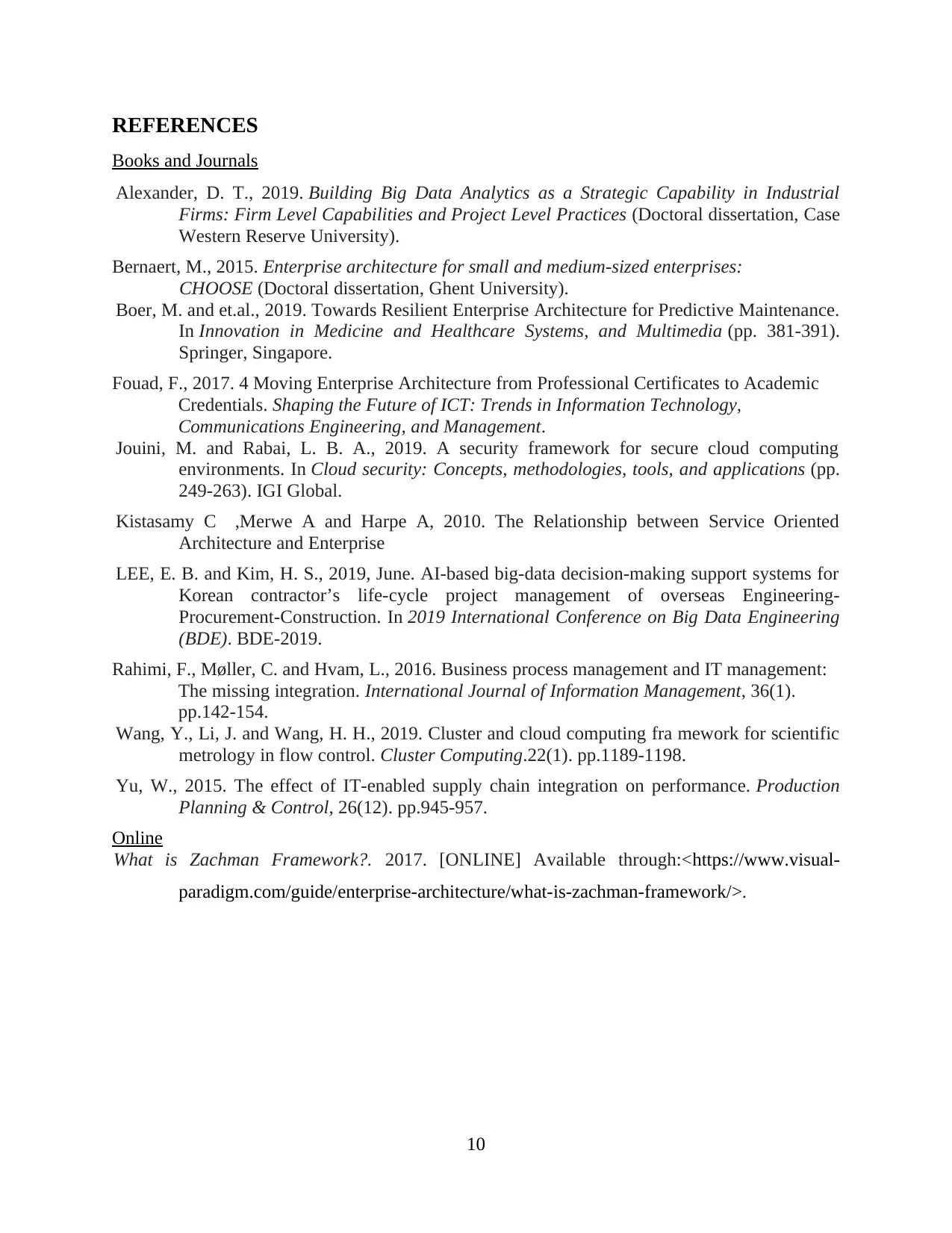
REFERENCES
Books and Journals
Alexander, D. T., 2019. Building Big Data Analytics as a Strategic Capability in Industrial
Firms: Firm Level Capabilities and Project Level Practices (Doctoral dissertation, Case
Western Reserve University).
Bernaert, M., 2015. Enterprise architecture for small and medium-sized enterprises:
CHOOSE (Doctoral dissertation, Ghent University).
Boer, M. and et.al., 2019. Towards Resilient Enterprise Architecture for Predictive Maintenance.
In Innovation in Medicine and Healthcare Systems, and Multimedia (pp. 381-391).
Springer, Singapore.
Fouad, F., 2017. 4 Moving Enterprise Architecture from Professional Certificates to Academic
Credentials. Shaping the Future of ICT: Trends in Information Technology,
Communications Engineering, and Management.
Jouini, M. and Rabai, L. B. A., 2019. A security framework for secure cloud computing
environments. In Cloud security: Concepts, methodologies, tools, and applications (pp.
249-263). IGI Global.
Kistasamy C ,Merwe A and Harpe A, 2010. The Relationship between Service Oriented
Architecture and Enterprise
LEE, E. B. and Kim, H. S., 2019, June. AI-based big-data decision-making support systems for
Korean contractor’s life-cycle project management of overseas Engineering-
Procurement-Construction. In 2019 International Conference on Big Data Engineering
(BDE). BDE-2019.
Rahimi, F., Møller, C. and Hvam, L., 2016. Business process management and IT management:
The missing integration. International Journal of Information Management, 36(1).
pp.142-154.
Wang, Y., Li, J. and Wang, H. H., 2019. Cluster and cloud computing fra mework for scientific
metrology in flow control. Cluster Computing.22(1). pp.1189-1198.
Yu, W., 2015. The effect of IT-enabled supply chain integration on performance. Production
Planning & Control, 26(12). pp.945-957.
Online
What is Zachman Framework?. 2017. [ONLINE] Available through:<https://www.visual-
paradigm.com/guide/enterprise-architecture/what-is-zachman-framework/>.
10
Books and Journals
Alexander, D. T., 2019. Building Big Data Analytics as a Strategic Capability in Industrial
Firms: Firm Level Capabilities and Project Level Practices (Doctoral dissertation, Case
Western Reserve University).
Bernaert, M., 2015. Enterprise architecture for small and medium-sized enterprises:
CHOOSE (Doctoral dissertation, Ghent University).
Boer, M. and et.al., 2019. Towards Resilient Enterprise Architecture for Predictive Maintenance.
In Innovation in Medicine and Healthcare Systems, and Multimedia (pp. 381-391).
Springer, Singapore.
Fouad, F., 2017. 4 Moving Enterprise Architecture from Professional Certificates to Academic
Credentials. Shaping the Future of ICT: Trends in Information Technology,
Communications Engineering, and Management.
Jouini, M. and Rabai, L. B. A., 2019. A security framework for secure cloud computing
environments. In Cloud security: Concepts, methodologies, tools, and applications (pp.
249-263). IGI Global.
Kistasamy C ,Merwe A and Harpe A, 2010. The Relationship between Service Oriented
Architecture and Enterprise
LEE, E. B. and Kim, H. S., 2019, June. AI-based big-data decision-making support systems for
Korean contractor’s life-cycle project management of overseas Engineering-
Procurement-Construction. In 2019 International Conference on Big Data Engineering
(BDE). BDE-2019.
Rahimi, F., Møller, C. and Hvam, L., 2016. Business process management and IT management:
The missing integration. International Journal of Information Management, 36(1).
pp.142-154.
Wang, Y., Li, J. and Wang, H. H., 2019. Cluster and cloud computing fra mework for scientific
metrology in flow control. Cluster Computing.22(1). pp.1189-1198.
Yu, W., 2015. The effect of IT-enabled supply chain integration on performance. Production
Planning & Control, 26(12). pp.945-957.
Online
What is Zachman Framework?. 2017. [ONLINE] Available through:<https://www.visual-
paradigm.com/guide/enterprise-architecture/what-is-zachman-framework/>.
10
⊘ This is a preview!⊘
Do you want full access?
Subscribe today to unlock all pages.

Trusted by 1+ million students worldwide
1 out of 12
Related Documents
Your All-in-One AI-Powered Toolkit for Academic Success.
+13062052269
info@desklib.com
Available 24*7 on WhatsApp / Email
![[object Object]](/_next/static/media/star-bottom.7253800d.svg)
Unlock your academic potential
Copyright © 2020–2025 A2Z Services. All Rights Reserved. Developed and managed by ZUCOL.





